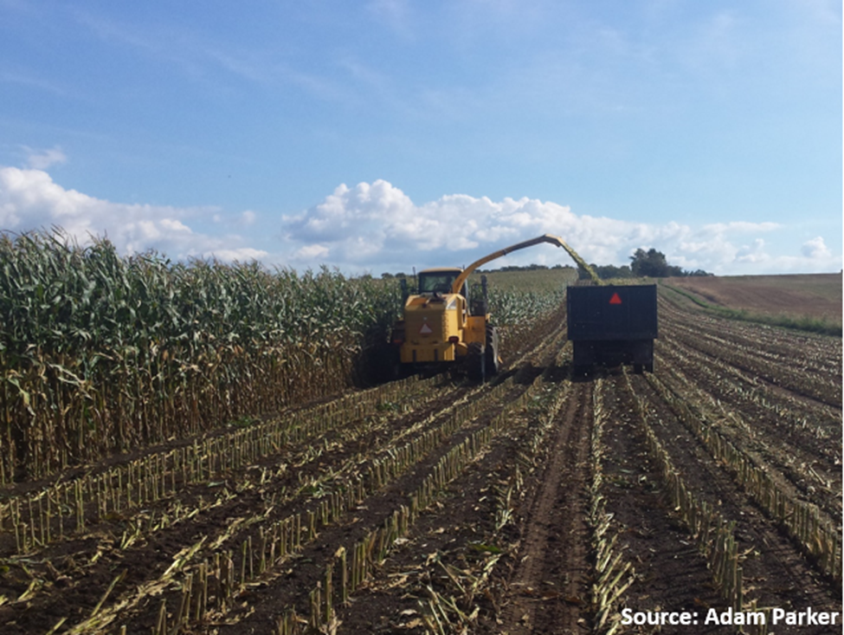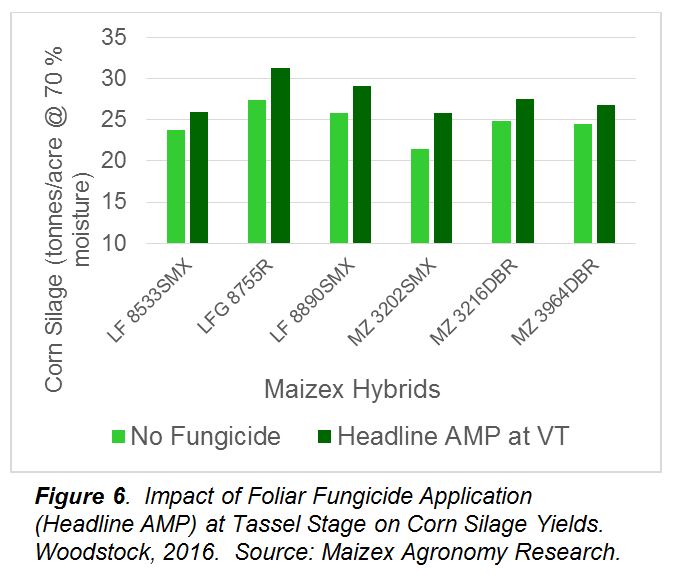Maximizing Your Maizex Silage Crop
April 5, 2017 | Category: Agronomy |Right now is a great time to review your crop plans before the spring rush. This includes silage corn, which produces the highest yield of energy per acre for ruminant production out of any crop produced in Canada. Corn harvested for silage offers a consistent product year to year and helps alleviate the harvest risk associated with other forage crops. This article will explore a number of management decisions that can help you fine tune your corn silage production and increase the productivity of your farm.

Choosing a Hybrid
To start off you need to select a variety that will fit your farm and produce an end product that is desirable for you. At Maizex, we have an outstanding lineup of Silage Specific varieties as well as a wide selection of grain hybrids that make excellent Dual Purpose Silage. A number of factors including: type of livestock, production rate, desired ration, other forage availability, rotation, acreage, harvest window, soil type, storage options, harvest flexibility, maturity or other management options will all influence which hybrids will perform best on your farm.
Leafy and Leafy Floury hybrids offer top tonnage, high fiber digestibility, readily available starch, overall excellent feed quality, and come with trait options for rotated ground, corn on corn and conventional acres. It is recommended that a Leafy hybrid is paired with a Dual Purpose companion for a portion of your silage acres to allow for flexibility at the end of harvest. Leafy hybrids are not designed to go to maturity or to be harvested for grain. Please note that our silage specific maturity ratings are already adjusted to silage maturity.
Dual Purpose hybrids make an energy dense ration, provide great feed quality and can yield excellent tonnage. Dual purpose options also come with a full range of the trait offerings and provide greater harvest flexibility. When selecting a dual purpose hybrid, start with a hybrid that has the desired trait offerings that you need and a maturity that is 100 – 200 CHU or 4-8 days Relative Maturity longer than your normal grain corn for your area. Look for a hybrid that has a tall, robust stature and offers high grain yield. Approximately 50% of the dry matter harvested in silage comes from the grain content.
Corn Silage Plant Populations
Plant populations for silage should be adjusted according to soil type, fertility, variety and type of corn that you are planting. Leafy varieties should be planted at a population of 27,000ppa-30,000ppa. These are large, robust plants that fill in a normal canopy at a lower population. Their long, girthy ears flex with the extra room. Since they naturally have less lignin in the stalk, the reduced population helps to keep a thick, strong stalk that avoids lodging. This is doubly beneficial because the greater the diameter of the stalk, the greater the pith-to-rind ratio which offers higher digestibility.
Dual Purpose hybrids can be pushed to higher planting densities. To achieve maximum yield from a dual purpose corn, plant populations can be pushed up to 35,000ppa-38,000ppa. The principle on this is to maximize number of plants, leaves and ears per acre for maximum tonnage. Moisture availability, fertility and management have to be optimum to support these high populations. Dual purpose silage can have a higher grain to stover ratio which can lead to a higher energy content feed, although whole plant digestibility and starch availability is often lower on these hybrids. To increase fiber digestibility on a Dual Purpose, it has been shown that by reducing the plant population to 30,000ppa-33,000ppa, the fiber digestibility increases given a greater pith-to-rind ratio (Figure 3). If the correct Dual Purpose hybrid is selected for this lower population, minimal tonnage will be lost.

Below is a cross section of two corn stalks that were planted at different populations. The stalk on the left will have a higher Pith:Rind ratio which results in higher fiber digestibility. Note: the pith is the white, soft and porous material in the middle of the stalk; the rind is the coarse, hard and lignified layer on the outer portion of the stalk.

Corn Silage Fertility
In order for your livestock to have the highest production possible, they must be fed well. The same applies to your crops – if you want to maximize your silage yield, you must feed the crop properly. High yielding corn silage crops of 25-30 tonnes per acre require and remove a lot of nutrients. Below (Figure 4) is a chart showing how much a 25 tonne crop of corn silage removes compared to a grain corn and soybean crop. Ultimately, if a corn silage crop does not have adequate fertility it will never achieve its full potential. It is imperative to test your soils and apply the necessary fertilizer to achieve your desired yield. This can be done in many ways, but it comes back to the basics of manure management, starter fertilizers and nutrient budgets.

Nitrogen rates are also important; providing the crop with a sufficient amount of nitrogen can increase yield as well as crude protein content. Figure 5 illustrates the improvements in both yield and protein by ensuring adequate nitrogen fertilization. At Maizex, we have several tools to help with determining your fertility program. We have developed the Maizex P+K tracker to help with your fertilizer recommendations and record keeping. In addition, there is the new Maizex N Tracker that is available on our website; it will help you forecast your crops nitrogen needs and make in season sidedress recommendations. Ask your Maizex representative today about our fertility tools.

Foliar Fungicides on Corn Silage
Another management strategy that Maizex is researching is the use of fungicides in corn silage production. The application of a foliar fungicide at VT (tassel) is a common practice in corn production today. There are several different benefits to applying foliar fungicides to corn silage: increased yield, improved feed quality and reduced mycotoxin levels.
Fungicides help to keep plants greener and healthier which allows them to produce more grain and plant material. Maizex and BASF have done numerous trials to evaluate the yield response of silage corn to a VT-R2 applied fungicide. Figure 6 illustrates the dramatic yield gain at the Maizex site near Woodstock in 2016; notice that yield gain in some hybrids are in the range of 3-4 tonnes of silage per acre. These yield improvements are generally more than expected, but does give an indication for what yield improvement could be attained. BASF reports that on 51 small and large scale trials across Ontario and Quebec where 4 different fungicides were applied at VT-R2 on silage corn, there was a 1.3 tonnes/ac advantage on average to applying a foliar fungicide to silage corn. A 1.3 tonnes/ac increase in yield is significant and the cost of a foliar fungicide application provided an excellent return on investment. One caution would be that when you apply a foliar fungicide to silage corn, the moisture content at harvest will be 3-4% higher than if a fungicide was not applied. This can help create a wider harvest window. Consider applying a fungicide to a shorter season variety to keep the plant alive longer and allow the starch to set up for a longer period of time. However, the slower drydown can also be a detriment; if your silage varieties are already at full maturity, applying a fungicide can add up to a week of harvest delay which may be too late for the optimum harvest period in your area.

Applying fungicides to silage corn can also increase the quality of the feed. Fungicides help to keep the plant leaves healthy and free from disease. Harvesting a healthier plant results in a higher quality feed with higher productivity out of your livestock. BASF has conducted 23 trials over the past six years in Ontario and Quebec with an average increase of 65.12 kg of milk/tonne when a VT fungicide was applied to corn silage fields (see Figure 7). When calculated out to a per acre basis and assuming a yield of 25 tonnes/ac, this equates to an additional 1709L of milk per acre. If producers could achieve even a portion of that increase in feed quality in their operation, it provides a considerable return on investment.

Maizex is conducting trials in 2017 to evaluate the use of foliar fungicides and their reduction of mycotoxins in feed samples. The indication to date is positive but more testing is needed to fully understand effectiveness. A suggestion would be that if a producer is looking to reduce mycotoxin levels in their feed, products such as Proline®, Caramba® or Caramba® co-mixed products such as Headline® AMP should be considered given their control of diseases that can lead to mycotoxin production.
Given how foliar fungicides are demonstrating significant improvements on corn silage production, we suggest that you consider using a foliar fungicide on your Maizex silage acres in 2017.
Summary
The decisions you make on varieties, plant population, fertility programs and plant health management can significantly impact your bottom line. Consider some of the above management strategies with your Maizex silage acres for 2017 to improve production on your farm. Contact your local Maizex representative for your specific recommendations.
Like what you’re reading? Sign up to receive weekly agronomy updates from Greg Stewart and the Maizex Agronomy Team right to your inbox! CLICK HERE
